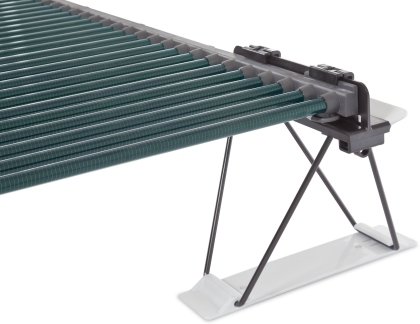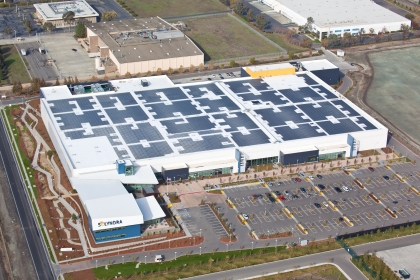China's solar rise seen in Solyndra's fall
Rick Merritt
8/31/2011 1:09 PM EDT
SAN JOSE, Calif. – High manufacturing costs, a niche product form factor, massive competing investments from China and a sluggish economy are all being blamed for the demise of Solyndra, one of the most high-profile and innovative solar panel makers in the U.S. The Fremont, Calif.-based solar panel maker, whose large fabs are a landmark along Silicon Valley's I-880 freeway, announced it plans to file for Chapter 11 bankruptcy.
The company's problems do not reflect on the potential of its emerging copper indium gallium selenide (CIGS) technology or thin film approaches. Nevertheless, Solyndra's demise may scare investors away from backing such alternatives in the face of mainstream crystalline technology, observers fear.
"This is a sad day for solar," said Paula Mints, a principal solar analyst at Navigant Consulting Inc. (Palo Alto, Calif.). "People will make simple assumptions based on this one case and that’s unfortunate because they should not," Mints said.
There's nothing fundamentally wrong with CIGs or thin-film technologies that have won support from private and public investors especially in the U.S. But China has made huge investments in mass producing the existing crystalline technology that currently dominates the solar panel market.
About 54 percent of all solar panels, mainly using crystalline technology, came from China and Taiwan in 2010, a figure expected to rise to 60 percent in this year. China's manufacturers started aggressively pricing the panels last year at rates as low as $1.20 per Watt, lower than Solyndra's manufacturing costs.
"This is not healthy for the industry because profit margins are just too low," said Mints. Compared to crystalline, CIGS is "very hard to manufacture—it's complex and there's no real standardization for it yet," Mints said.
Due to the wide use of government incentives for installing solar panels, price is not the only factor driving the industry, but it is a significant one, she said.
Solyndra created a novel cylindrical solar cell and panel design to ease the job of installing rooftop panels for homes and businesses, its focus markets. However, the majority of solar sales are currently going to large utility-scale installations that prefer lower cost, conventional flat panel designs.

Solyndra's 200 Series-7 was designed for easy rooftop installation.
"Solyndra could not achieve full-scale operations rapidly enough to compete in the near term with the resources of larger foreign manufacturers," according to a company statement quoted in a report by the San Jose Mercury News. About 1,100 people will be laid off at the company, the report said.
The company reportedly raised more than a billion dollars in venture capital and got a $535 million loan guarantee from the U.S., Department of Energy. President Barack Obama visited the Fremont plant last year, holding it up as an example of U.S. innovation in clean tech.
Last week, Solyndra founder Chris Gronet announced he was stepping down from his role as chairman and chief executive of the company "pursuing new opportunities and challenges in clean tech."
A Stanford graduate and PhD in semiconductor processing, Gronet sold his first startup to Applied Materials in 1991. He worked as an executive there before leaving for a stint at a venture capital firm that lead to the formation of Solyndra.
Two other solar cell manufacturers filed for bankruptcy earlier this month, including Spectrawatt Inc., a solar cell maker originally spun off from Intel Corp. in 2008. Evergreen Solar Inc. announced it is closing a U.S. plant but maintaining one in China.

Solyndra's Fab 2 is a clean tech icon on Silicon Valley's I-880.
Patk0317
8/31/2011 1:49 PM EDT
Gee $535 Billion of our (U.S. Taxpayer)money down the drain ... and another 1,000 people out of work. Perhaps they should have perfected the technology and manufacturing process and gotten some customers before they ramped up and burned through all that money.
8/31/2011 3:15 PM EDT
There is nothing wrong with the technologies; yet, it can't compete with $1.20 per Watt solar panel manufactured in China. Mints said "This is not healthy for the industry because profit margins are just too low; CIGS is very hard to manufacture—it's complex and there's no real standardization for it yet."
Cost ultimately is the driver of getting the market. A government subsidized will drive the price down. Maybe, that's the reason Chinese made Solar panel can be sold in lower cost. Yet, sooner or later, Chinese government will cut the subsidiary off and the companies have to be able to sustain its operation with the revenue.
It is sad to see a clean tech company going down. I hope the Chapter 11 will just help the company to get out of trouble and re-organize itself to compete in the market. We need better energy.
copyright ©2011 UBM Electronics,
A UBM company
All rights reserved http://www.eetimes.com